Comprehensive Report on International Business Environment Factors
VerifiedAdded on 2019/12/28
|12
|3801
|256
Report
AI Summary
This report delves into the multifaceted aspects of the international business environment, exploring the dynamics of internationalization and globalization. It examines various factors influencing businesses operating across borders, including the modes of globalization, the impact of technological advancements, and the roles of both large and small countries. The report discusses different methods of internationalization such as export-based and equity-based methods, providing examples like Unilever and Cemex. It also covers key theories like the product life cycle theory, the theory of incremental internationalization, and Dunning's electric paradigm, along with ownership, location, and internationalization advantages. Furthermore, the report analyzes supply-related, political, and demand-related factors that influence internationalization decisions, along with the impact of organization structure and leadership styles within international businesses, using examples such as Ford and Volvo. This report offers a comprehensive overview of the international business environment.
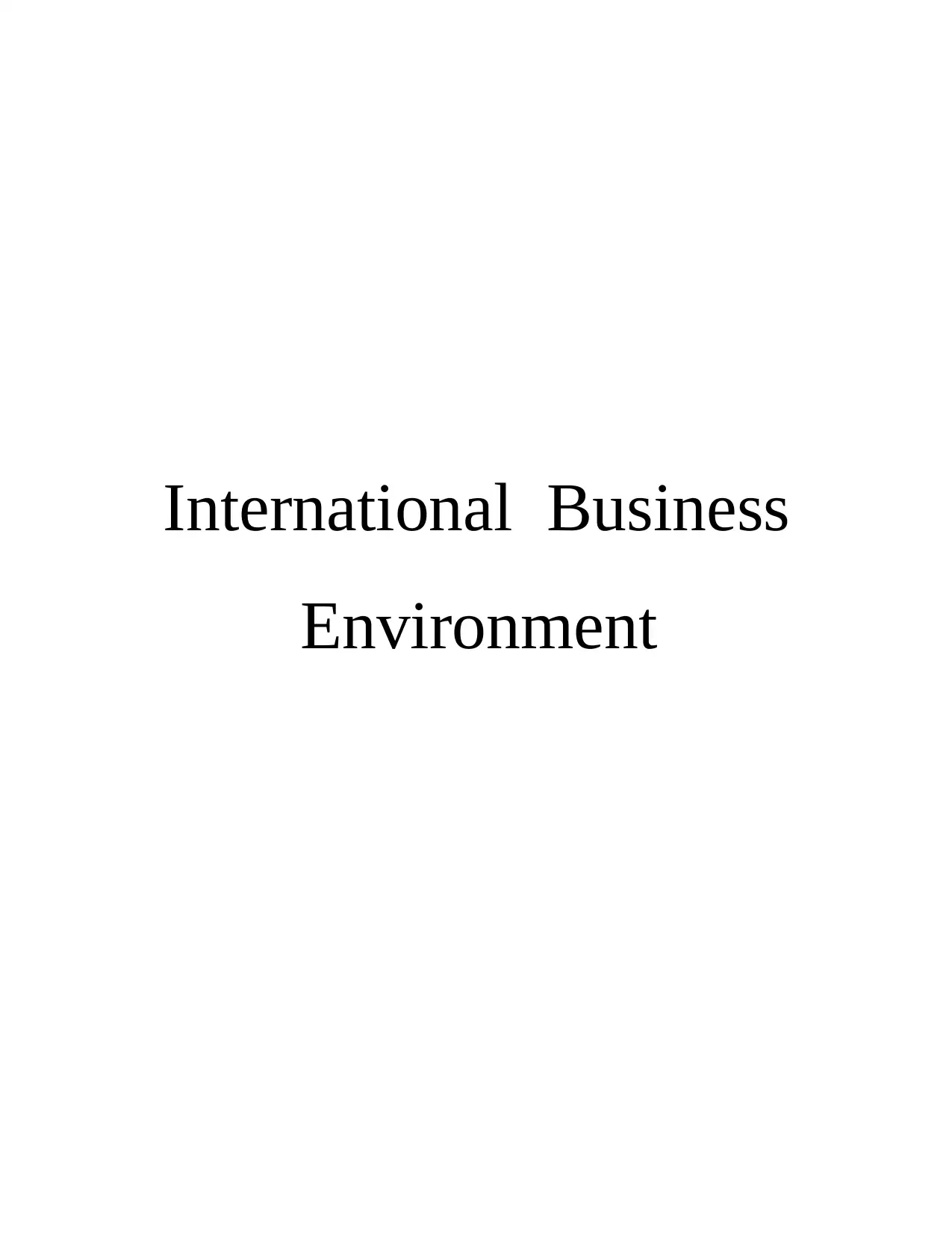
International Business
Environment
Environment
Paraphrase This Document
Need a fresh take? Get an instant paraphrase of this document with our AI Paraphraser

Table of Contents
INTRODUCTION...........................................................................................................................3
TASK...............................................................................................................................................3
CONCLUSION..............................................................................................................................10
REFRENCES.................................................................................................................................11
INTRODUCTION...........................................................................................................................3
TASK...............................................................................................................................................3
CONCLUSION..............................................................................................................................10
REFRENCES.................................................................................................................................11
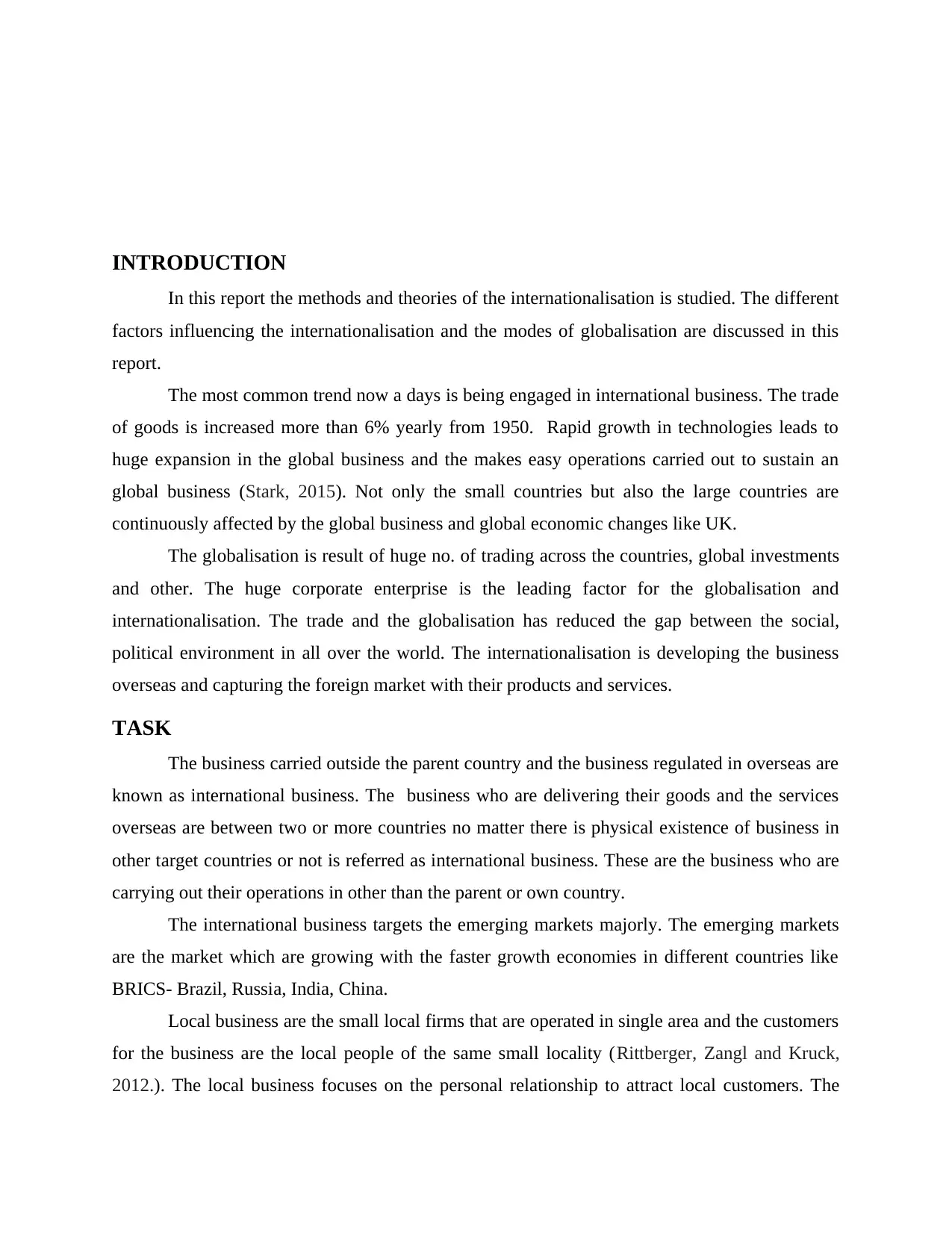
INTRODUCTION
In this report the methods and theories of the internationalisation is studied. The different
factors influencing the internationalisation and the modes of globalisation are discussed in this
report.
The most common trend now a days is being engaged in international business. The trade
of goods is increased more than 6% yearly from 1950. Rapid growth in technologies leads to
huge expansion in the global business and the makes easy operations carried out to sustain an
global business (Stark, 2015). Not only the small countries but also the large countries are
continuously affected by the global business and global economic changes like UK.
The globalisation is result of huge no. of trading across the countries, global investments
and other. The huge corporate enterprise is the leading factor for the globalisation and
internationalisation. The trade and the globalisation has reduced the gap between the social,
political environment in all over the world. The internationalisation is developing the business
overseas and capturing the foreign market with their products and services.
TASK
The business carried outside the parent country and the business regulated in overseas are
known as international business. The business who are delivering their goods and the services
overseas are between two or more countries no matter there is physical existence of business in
other target countries or not is referred as international business. These are the business who are
carrying out their operations in other than the parent or own country.
The international business targets the emerging markets majorly. The emerging markets
are the market which are growing with the faster growth economies in different countries like
BRICS- Brazil, Russia, India, China.
Local business are the small local firms that are operated in single area and the customers
for the business are the local people of the same small locality (Rittberger, Zangl and Kruck,
2012.). The local business focuses on the personal relationship to attract local customers. The
In this report the methods and theories of the internationalisation is studied. The different
factors influencing the internationalisation and the modes of globalisation are discussed in this
report.
The most common trend now a days is being engaged in international business. The trade
of goods is increased more than 6% yearly from 1950. Rapid growth in technologies leads to
huge expansion in the global business and the makes easy operations carried out to sustain an
global business (Stark, 2015). Not only the small countries but also the large countries are
continuously affected by the global business and global economic changes like UK.
The globalisation is result of huge no. of trading across the countries, global investments
and other. The huge corporate enterprise is the leading factor for the globalisation and
internationalisation. The trade and the globalisation has reduced the gap between the social,
political environment in all over the world. The internationalisation is developing the business
overseas and capturing the foreign market with their products and services.
TASK
The business carried outside the parent country and the business regulated in overseas are
known as international business. The business who are delivering their goods and the services
overseas are between two or more countries no matter there is physical existence of business in
other target countries or not is referred as international business. These are the business who are
carrying out their operations in other than the parent or own country.
The international business targets the emerging markets majorly. The emerging markets
are the market which are growing with the faster growth economies in different countries like
BRICS- Brazil, Russia, India, China.
Local business are the small local firms that are operated in single area and the customers
for the business are the local people of the same small locality (Rittberger, Zangl and Kruck,
2012.). The local business focuses on the personal relationship to attract local customers. The
⊘ This is a preview!⊘
Do you want full access?
Subscribe today to unlock all pages.

Trusted by 1+ million students worldwide
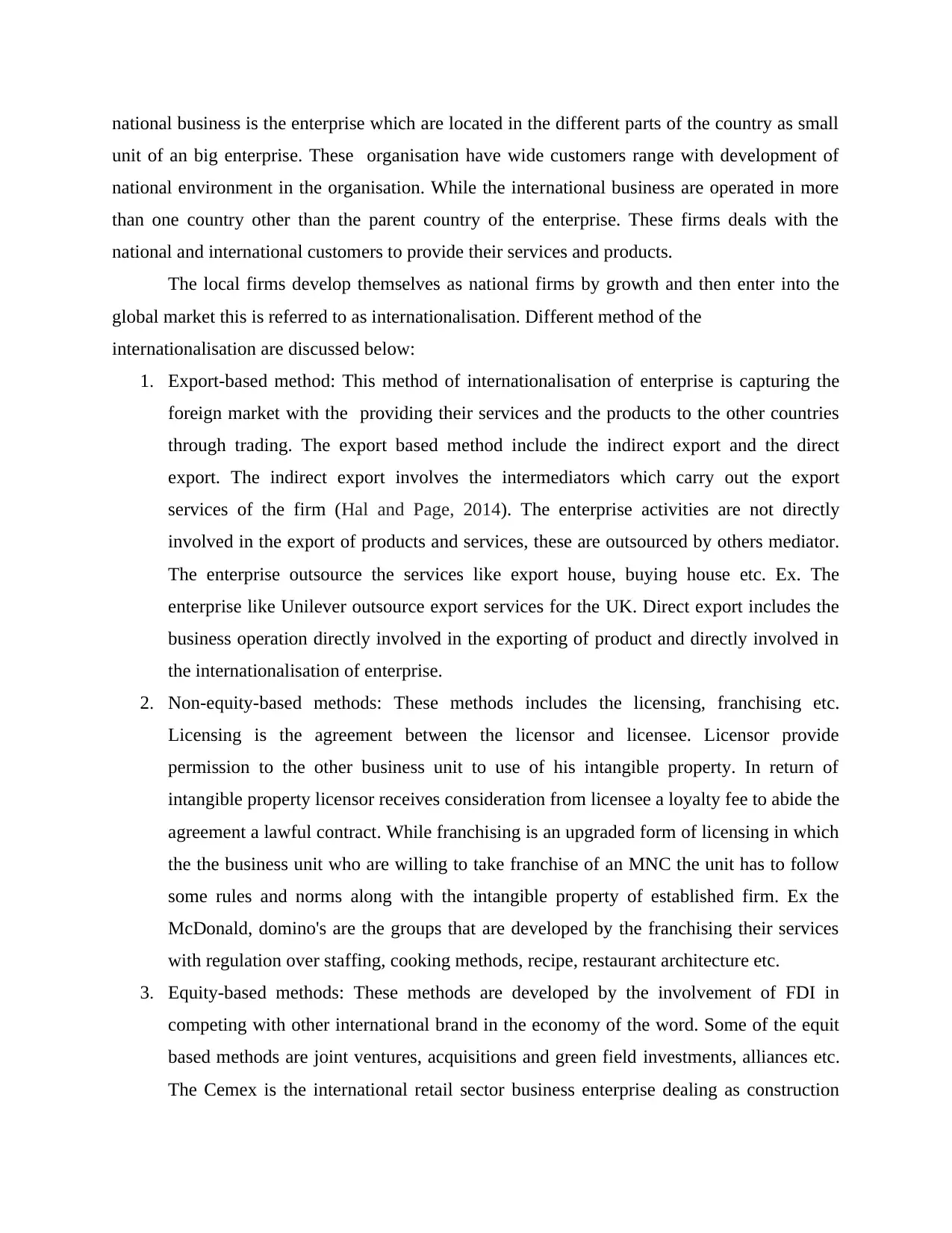
national business is the enterprise which are located in the different parts of the country as small
unit of an big enterprise. These organisation have wide customers range with development of
national environment in the organisation. While the international business are operated in more
than one country other than the parent country of the enterprise. These firms deals with the
national and international customers to provide their services and products.
The local firms develop themselves as national firms by growth and then enter into the
global market this is referred to as internationalisation. Different method of the
internationalisation are discussed below:
1. Export-based method: This method of internationalisation of enterprise is capturing the
foreign market with the providing their services and the products to the other countries
through trading. The export based method include the indirect export and the direct
export. The indirect export involves the intermediators which carry out the export
services of the firm (Hal and Page, 2014). The enterprise activities are not directly
involved in the export of products and services, these are outsourced by others mediator.
The enterprise outsource the services like export house, buying house etc. Ex. The
enterprise like Unilever outsource export services for the UK. Direct export includes the
business operation directly involved in the exporting of product and directly involved in
the internationalisation of enterprise.
2. Non-equity-based methods: These methods includes the licensing, franchising etc.
Licensing is the agreement between the licensor and licensee. Licensor provide
permission to the other business unit to use of his intangible property. In return of
intangible property licensor receives consideration from licensee a loyalty fee to abide the
agreement a lawful contract. While franchising is an upgraded form of licensing in which
the the business unit who are willing to take franchise of an MNC the unit has to follow
some rules and norms along with the intangible property of established firm. Ex the
McDonald, domino's are the groups that are developed by the franchising their services
with regulation over staffing, cooking methods, recipe, restaurant architecture etc.
3. Equity-based methods: These methods are developed by the involvement of FDI in
competing with other international brand in the economy of the word. Some of the equit
based methods are joint ventures, acquisitions and green field investments, alliances etc.
The Cemex is the international retail sector business enterprise dealing as construction
unit of an big enterprise. These organisation have wide customers range with development of
national environment in the organisation. While the international business are operated in more
than one country other than the parent country of the enterprise. These firms deals with the
national and international customers to provide their services and products.
The local firms develop themselves as national firms by growth and then enter into the
global market this is referred to as internationalisation. Different method of the
internationalisation are discussed below:
1. Export-based method: This method of internationalisation of enterprise is capturing the
foreign market with the providing their services and the products to the other countries
through trading. The export based method include the indirect export and the direct
export. The indirect export involves the intermediators which carry out the export
services of the firm (Hal and Page, 2014). The enterprise activities are not directly
involved in the export of products and services, these are outsourced by others mediator.
The enterprise outsource the services like export house, buying house etc. Ex. The
enterprise like Unilever outsource export services for the UK. Direct export includes the
business operation directly involved in the exporting of product and directly involved in
the internationalisation of enterprise.
2. Non-equity-based methods: These methods includes the licensing, franchising etc.
Licensing is the agreement between the licensor and licensee. Licensor provide
permission to the other business unit to use of his intangible property. In return of
intangible property licensor receives consideration from licensee a loyalty fee to abide the
agreement a lawful contract. While franchising is an upgraded form of licensing in which
the the business unit who are willing to take franchise of an MNC the unit has to follow
some rules and norms along with the intangible property of established firm. Ex the
McDonald, domino's are the groups that are developed by the franchising their services
with regulation over staffing, cooking methods, recipe, restaurant architecture etc.
3. Equity-based methods: These methods are developed by the involvement of FDI in
competing with other international brand in the economy of the word. Some of the equit
based methods are joint ventures, acquisitions and green field investments, alliances etc.
The Cemex is the international retail sector business enterprise dealing as construction
Paraphrase This Document
Need a fresh take? Get an instant paraphrase of this document with our AI Paraphraser
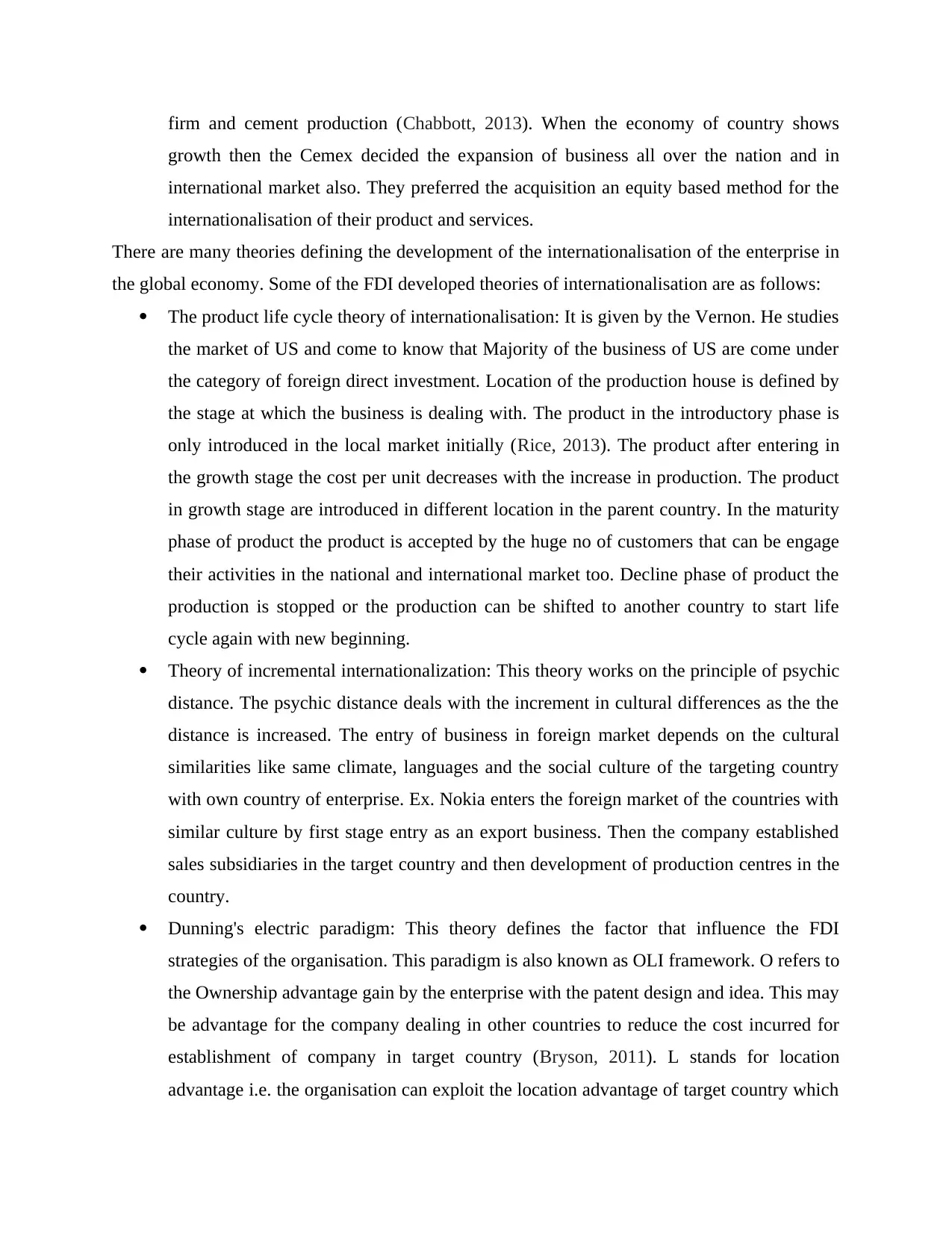
firm and cement production (Chabbott, 2013). When the economy of country shows
growth then the Cemex decided the expansion of business all over the nation and in
international market also. They preferred the acquisition an equity based method for the
internationalisation of their product and services.
There are many theories defining the development of the internationalisation of the enterprise in
the global economy. Some of the FDI developed theories of internationalisation are as follows:
The product life cycle theory of internationalisation: It is given by the Vernon. He studies
the market of US and come to know that Majority of the business of US are come under
the category of foreign direct investment. Location of the production house is defined by
the stage at which the business is dealing with. The product in the introductory phase is
only introduced in the local market initially (Rice, 2013). The product after entering in
the growth stage the cost per unit decreases with the increase in production. The product
in growth stage are introduced in different location in the parent country. In the maturity
phase of product the product is accepted by the huge no of customers that can be engage
their activities in the national and international market too. Decline phase of product the
production is stopped or the production can be shifted to another country to start life
cycle again with new beginning.
Theory of incremental internationalization: This theory works on the principle of psychic
distance. The psychic distance deals with the increment in cultural differences as the the
distance is increased. The entry of business in foreign market depends on the cultural
similarities like same climate, languages and the social culture of the targeting country
with own country of enterprise. Ex. Nokia enters the foreign market of the countries with
similar culture by first stage entry as an export business. Then the company established
sales subsidiaries in the target country and then development of production centres in the
country.
Dunning's electric paradigm: This theory defines the factor that influence the FDI
strategies of the organisation. This paradigm is also known as OLI framework. O refers to
the Ownership advantage gain by the enterprise with the patent design and idea. This may
be advantage for the company dealing in other countries to reduce the cost incurred for
establishment of company in target country (Bryson, 2011). L stands for location
advantage i.e. the organisation can exploit the location advantage of target country which
growth then the Cemex decided the expansion of business all over the nation and in
international market also. They preferred the acquisition an equity based method for the
internationalisation of their product and services.
There are many theories defining the development of the internationalisation of the enterprise in
the global economy. Some of the FDI developed theories of internationalisation are as follows:
The product life cycle theory of internationalisation: It is given by the Vernon. He studies
the market of US and come to know that Majority of the business of US are come under
the category of foreign direct investment. Location of the production house is defined by
the stage at which the business is dealing with. The product in the introductory phase is
only introduced in the local market initially (Rice, 2013). The product after entering in
the growth stage the cost per unit decreases with the increase in production. The product
in growth stage are introduced in different location in the parent country. In the maturity
phase of product the product is accepted by the huge no of customers that can be engage
their activities in the national and international market too. Decline phase of product the
production is stopped or the production can be shifted to another country to start life
cycle again with new beginning.
Theory of incremental internationalization: This theory works on the principle of psychic
distance. The psychic distance deals with the increment in cultural differences as the the
distance is increased. The entry of business in foreign market depends on the cultural
similarities like same climate, languages and the social culture of the targeting country
with own country of enterprise. Ex. Nokia enters the foreign market of the countries with
similar culture by first stage entry as an export business. Then the company established
sales subsidiaries in the target country and then development of production centres in the
country.
Dunning's electric paradigm: This theory defines the factor that influence the FDI
strategies of the organisation. This paradigm is also known as OLI framework. O refers to
the Ownership advantage gain by the enterprise with the patent design and idea. This may
be advantage for the company dealing in other countries to reduce the cost incurred for
establishment of company in target country (Bryson, 2011). L stands for location
advantage i.e. the organisation can exploit the location advantage of target country which
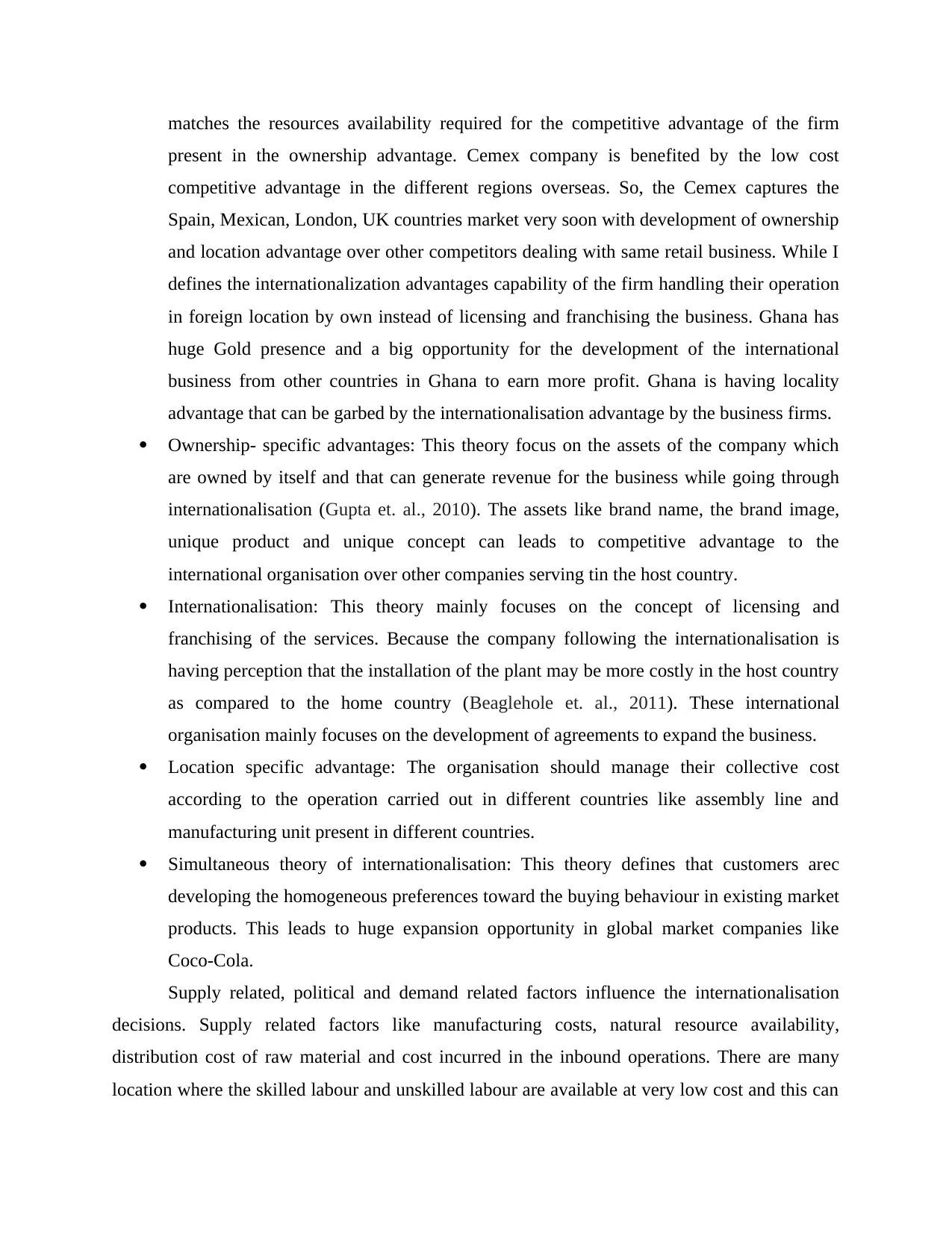
matches the resources availability required for the competitive advantage of the firm
present in the ownership advantage. Cemex company is benefited by the low cost
competitive advantage in the different regions overseas. So, the Cemex captures the
Spain, Mexican, London, UK countries market very soon with development of ownership
and location advantage over other competitors dealing with same retail business. While I
defines the internationalization advantages capability of the firm handling their operation
in foreign location by own instead of licensing and franchising the business. Ghana has
huge Gold presence and a big opportunity for the development of the international
business from other countries in Ghana to earn more profit. Ghana is having locality
advantage that can be garbed by the internationalisation advantage by the business firms.
Ownership- specific advantages: This theory focus on the assets of the company which
are owned by itself and that can generate revenue for the business while going through
internationalisation (Gupta et. al., 2010). The assets like brand name, the brand image,
unique product and unique concept can leads to competitive advantage to the
international organisation over other companies serving tin the host country.
Internationalisation: This theory mainly focuses on the concept of licensing and
franchising of the services. Because the company following the internationalisation is
having perception that the installation of the plant may be more costly in the host country
as compared to the home country (Beaglehole et. al., 2011). These international
organisation mainly focuses on the development of agreements to expand the business.
Location specific advantage: The organisation should manage their collective cost
according to the operation carried out in different countries like assembly line and
manufacturing unit present in different countries.
Simultaneous theory of internationalisation: This theory defines that customers arec
developing the homogeneous preferences toward the buying behaviour in existing market
products. This leads to huge expansion opportunity in global market companies like
Coco-Cola.
Supply related, political and demand related factors influence the internationalisation
decisions. Supply related factors like manufacturing costs, natural resource availability,
distribution cost of raw material and cost incurred in the inbound operations. There are many
location where the skilled labour and unskilled labour are available at very low cost and this can
present in the ownership advantage. Cemex company is benefited by the low cost
competitive advantage in the different regions overseas. So, the Cemex captures the
Spain, Mexican, London, UK countries market very soon with development of ownership
and location advantage over other competitors dealing with same retail business. While I
defines the internationalization advantages capability of the firm handling their operation
in foreign location by own instead of licensing and franchising the business. Ghana has
huge Gold presence and a big opportunity for the development of the international
business from other countries in Ghana to earn more profit. Ghana is having locality
advantage that can be garbed by the internationalisation advantage by the business firms.
Ownership- specific advantages: This theory focus on the assets of the company which
are owned by itself and that can generate revenue for the business while going through
internationalisation (Gupta et. al., 2010). The assets like brand name, the brand image,
unique product and unique concept can leads to competitive advantage to the
international organisation over other companies serving tin the host country.
Internationalisation: This theory mainly focuses on the concept of licensing and
franchising of the services. Because the company following the internationalisation is
having perception that the installation of the plant may be more costly in the host country
as compared to the home country (Beaglehole et. al., 2011). These international
organisation mainly focuses on the development of agreements to expand the business.
Location specific advantage: The organisation should manage their collective cost
according to the operation carried out in different countries like assembly line and
manufacturing unit present in different countries.
Simultaneous theory of internationalisation: This theory defines that customers arec
developing the homogeneous preferences toward the buying behaviour in existing market
products. This leads to huge expansion opportunity in global market companies like
Coco-Cola.
Supply related, political and demand related factors influence the internationalisation
decisions. Supply related factors like manufacturing costs, natural resource availability,
distribution cost of raw material and cost incurred in the inbound operations. There are many
location where the skilled labour and unskilled labour are available at very low cost and this can
⊘ This is a preview!⊘
Do you want full access?
Subscribe today to unlock all pages.

Trusted by 1+ million students worldwide
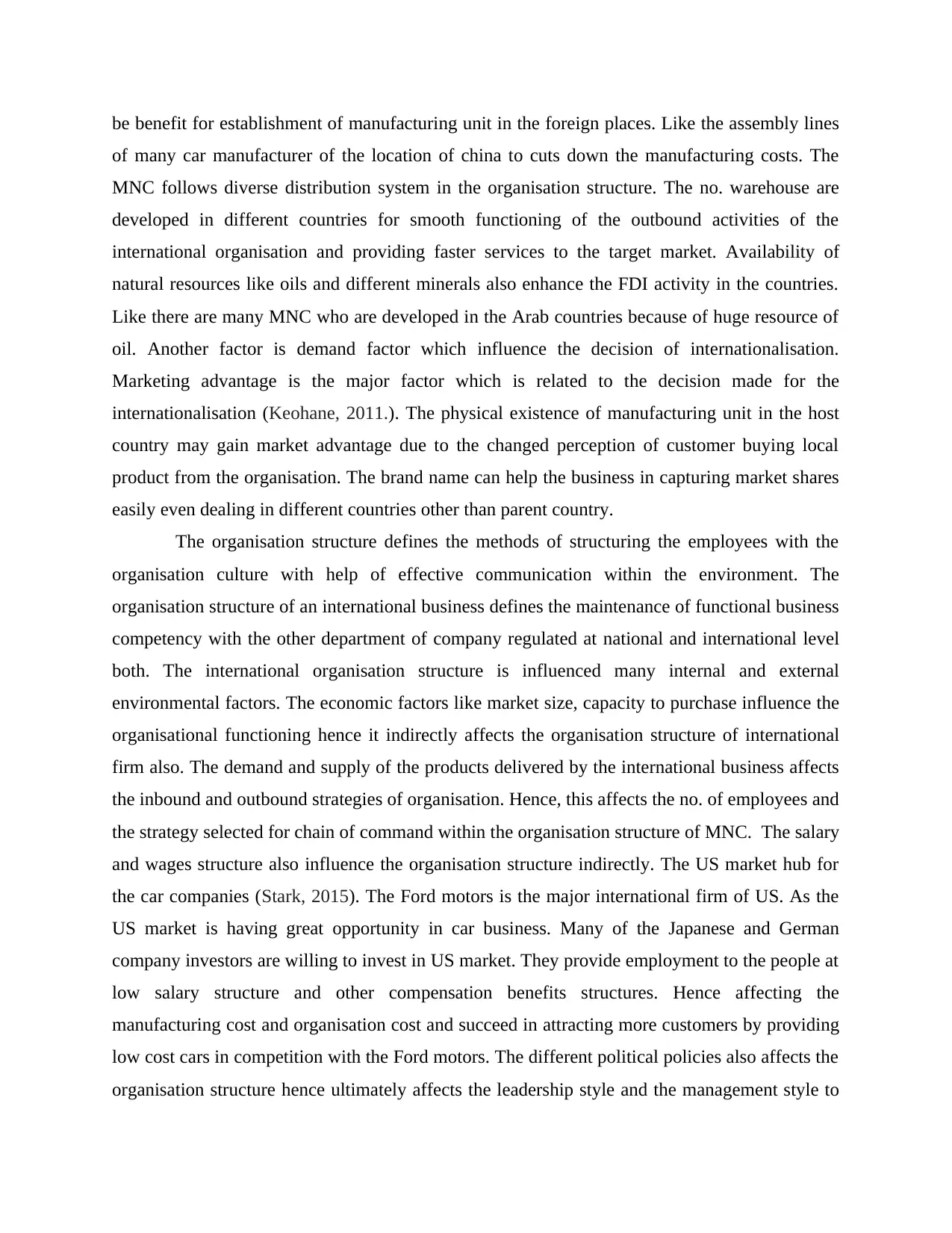
be benefit for establishment of manufacturing unit in the foreign places. Like the assembly lines
of many car manufacturer of the location of china to cuts down the manufacturing costs. The
MNC follows diverse distribution system in the organisation structure. The no. warehouse are
developed in different countries for smooth functioning of the outbound activities of the
international organisation and providing faster services to the target market. Availability of
natural resources like oils and different minerals also enhance the FDI activity in the countries.
Like there are many MNC who are developed in the Arab countries because of huge resource of
oil. Another factor is demand factor which influence the decision of internationalisation.
Marketing advantage is the major factor which is related to the decision made for the
internationalisation (Keohane, 2011.). The physical existence of manufacturing unit in the host
country may gain market advantage due to the changed perception of customer buying local
product from the organisation. The brand name can help the business in capturing market shares
easily even dealing in different countries other than parent country.
The organisation structure defines the methods of structuring the employees with the
organisation culture with help of effective communication within the environment. The
organisation structure of an international business defines the maintenance of functional business
competency with the other department of company regulated at national and international level
both. The international organisation structure is influenced many internal and external
environmental factors. The economic factors like market size, capacity to purchase influence the
organisational functioning hence it indirectly affects the organisation structure of international
firm also. The demand and supply of the products delivered by the international business affects
the inbound and outbound strategies of organisation. Hence, this affects the no. of employees and
the strategy selected for chain of command within the organisation structure of MNC. The salary
and wages structure also influence the organisation structure indirectly. The US market hub for
the car companies (Stark, 2015). The Ford motors is the major international firm of US. As the
US market is having great opportunity in car business. Many of the Japanese and German
company investors are willing to invest in US market. They provide employment to the people at
low salary structure and other compensation benefits structures. Hence affecting the
manufacturing cost and organisation cost and succeed in attracting more customers by providing
low cost cars in competition with the Ford motors. The different political policies also affects the
organisation structure hence ultimately affects the leadership style and the management style to
of many car manufacturer of the location of china to cuts down the manufacturing costs. The
MNC follows diverse distribution system in the organisation structure. The no. warehouse are
developed in different countries for smooth functioning of the outbound activities of the
international organisation and providing faster services to the target market. Availability of
natural resources like oils and different minerals also enhance the FDI activity in the countries.
Like there are many MNC who are developed in the Arab countries because of huge resource of
oil. Another factor is demand factor which influence the decision of internationalisation.
Marketing advantage is the major factor which is related to the decision made for the
internationalisation (Keohane, 2011.). The physical existence of manufacturing unit in the host
country may gain market advantage due to the changed perception of customer buying local
product from the organisation. The brand name can help the business in capturing market shares
easily even dealing in different countries other than parent country.
The organisation structure defines the methods of structuring the employees with the
organisation culture with help of effective communication within the environment. The
organisation structure of an international business defines the maintenance of functional business
competency with the other department of company regulated at national and international level
both. The international organisation structure is influenced many internal and external
environmental factors. The economic factors like market size, capacity to purchase influence the
organisational functioning hence it indirectly affects the organisation structure of international
firm also. The demand and supply of the products delivered by the international business affects
the inbound and outbound strategies of organisation. Hence, this affects the no. of employees and
the strategy selected for chain of command within the organisation structure of MNC. The salary
and wages structure also influence the organisation structure indirectly. The US market hub for
the car companies (Stark, 2015). The Ford motors is the major international firm of US. As the
US market is having great opportunity in car business. Many of the Japanese and German
company investors are willing to invest in US market. They provide employment to the people at
low salary structure and other compensation benefits structures. Hence affecting the
manufacturing cost and organisation cost and succeed in attracting more customers by providing
low cost cars in competition with the Ford motors. The different political policies also affects the
organisation structure hence ultimately affects the leadership style and the management style to
Paraphrase This Document
Need a fresh take? Get an instant paraphrase of this document with our AI Paraphraser

be implemented in the organisation. The Volvo company is first acquired by the Ford then
acquired by the Gelly an china citizens. He is having great relationship and support from the
Chinese political party. So, he established an production plant in the china with the continuous
help from the government of china. Hence it shows that the government and the political factors
of country influence the organisational development internationally to a large extent. The
government of the Germany invested in the market of cars and launched scrap page schemes
which attracts the customers in selling out new cars in return of old cars. Which enhanced the
revenue of the Renault. But Ford motors does no meet up with the government policy
expectation leads to loss. The socio culture and the psycho graphic factor influencing the
organisation structure are like values, beliefs affects the exp trait for the organisation which
influence the leadership style of the international business (Cantwell, Dunning and Lundan,
2010). The technological changes is the major factor that influence the working of employees
and in dealing with the operation internationally physically available at only one place. So the
technological advancement leads to the decrease in the requirement of the employees hence
affects the structure of organisation to be followed for defining job roles and responsibility of the
employees and the managers style for enhancing the motivation of employees. The Ghana of
south Africa is having gold resources. The many mining company are investing in the Ghana
gold mines to earn profit.
The national culture refers to the shared value, beliefs of the different people related to
the various regions of the single country. The national culture of an country is defined by the
acceptable behaviour of people living in that countries by each other. While the organisational
culture defines the nature and behaviour shown by the employees working for the organisation
within the premises of the company. The multinational companies have their own cooperative
culture and well defined ethical norms and values that are to be followed by the employee
working with the organisation whether in the parent country or host country. There is strong
relationship between the national culture and the organisational culture of host country and the
parent country to their respective nations (Shaffer, 2010). The Greet Hofstede studies the various
international companies and effect of the regional and national cultures on their organisational
behaviour which leads to development of Hofstede model. According to the hofstede there are
major 5 factors which influence the organisation culture and the employee behaviour in context
with international business. These factors are Power-distance, masculinity-femininity,
acquired by the Gelly an china citizens. He is having great relationship and support from the
Chinese political party. So, he established an production plant in the china with the continuous
help from the government of china. Hence it shows that the government and the political factors
of country influence the organisational development internationally to a large extent. The
government of the Germany invested in the market of cars and launched scrap page schemes
which attracts the customers in selling out new cars in return of old cars. Which enhanced the
revenue of the Renault. But Ford motors does no meet up with the government policy
expectation leads to loss. The socio culture and the psycho graphic factor influencing the
organisation structure are like values, beliefs affects the exp trait for the organisation which
influence the leadership style of the international business (Cantwell, Dunning and Lundan,
2010). The technological changes is the major factor that influence the working of employees
and in dealing with the operation internationally physically available at only one place. So the
technological advancement leads to the decrease in the requirement of the employees hence
affects the structure of organisation to be followed for defining job roles and responsibility of the
employees and the managers style for enhancing the motivation of employees. The Ghana of
south Africa is having gold resources. The many mining company are investing in the Ghana
gold mines to earn profit.
The national culture refers to the shared value, beliefs of the different people related to
the various regions of the single country. The national culture of an country is defined by the
acceptable behaviour of people living in that countries by each other. While the organisational
culture defines the nature and behaviour shown by the employees working for the organisation
within the premises of the company. The multinational companies have their own cooperative
culture and well defined ethical norms and values that are to be followed by the employee
working with the organisation whether in the parent country or host country. There is strong
relationship between the national culture and the organisational culture of host country and the
parent country to their respective nations (Shaffer, 2010). The Greet Hofstede studies the various
international companies and effect of the regional and national cultures on their organisational
behaviour which leads to development of Hofstede model. According to the hofstede there are
major 5 factors which influence the organisation culture and the employee behaviour in context
with international business. These factors are Power-distance, masculinity-femininity,
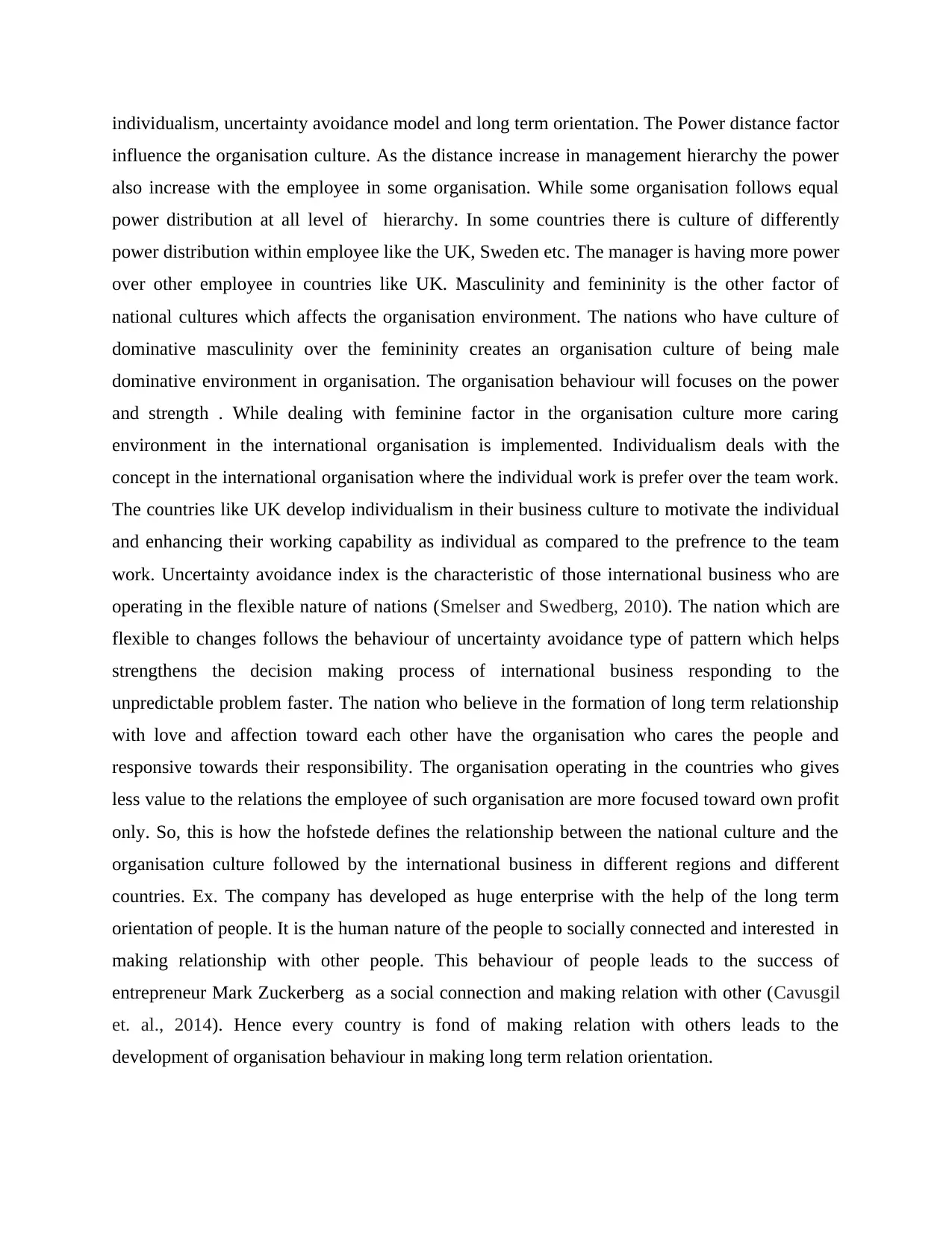
individualism, uncertainty avoidance model and long term orientation. The Power distance factor
influence the organisation culture. As the distance increase in management hierarchy the power
also increase with the employee in some organisation. While some organisation follows equal
power distribution at all level of hierarchy. In some countries there is culture of differently
power distribution within employee like the UK, Sweden etc. The manager is having more power
over other employee in countries like UK. Masculinity and femininity is the other factor of
national cultures which affects the organisation environment. The nations who have culture of
dominative masculinity over the femininity creates an organisation culture of being male
dominative environment in organisation. The organisation behaviour will focuses on the power
and strength . While dealing with feminine factor in the organisation culture more caring
environment in the international organisation is implemented. Individualism deals with the
concept in the international organisation where the individual work is prefer over the team work.
The countries like UK develop individualism in their business culture to motivate the individual
and enhancing their working capability as individual as compared to the prefrence to the team
work. Uncertainty avoidance index is the characteristic of those international business who are
operating in the flexible nature of nations (Smelser and Swedberg, 2010). The nation which are
flexible to changes follows the behaviour of uncertainty avoidance type of pattern which helps
strengthens the decision making process of international business responding to the
unpredictable problem faster. The nation who believe in the formation of long term relationship
with love and affection toward each other have the organisation who cares the people and
responsive towards their responsibility. The organisation operating in the countries who gives
less value to the relations the employee of such organisation are more focused toward own profit
only. So, this is how the hofstede defines the relationship between the national culture and the
organisation culture followed by the international business in different regions and different
countries. Ex. The company has developed as huge enterprise with the help of the long term
orientation of people. It is the human nature of the people to socially connected and interested in
making relationship with other people. This behaviour of people leads to the success of
entrepreneur Mark Zuckerberg as a social connection and making relation with other (Cavusgil
et. al., 2014). Hence every country is fond of making relation with others leads to the
development of organisation behaviour in making long term relation orientation.
influence the organisation culture. As the distance increase in management hierarchy the power
also increase with the employee in some organisation. While some organisation follows equal
power distribution at all level of hierarchy. In some countries there is culture of differently
power distribution within employee like the UK, Sweden etc. The manager is having more power
over other employee in countries like UK. Masculinity and femininity is the other factor of
national cultures which affects the organisation environment. The nations who have culture of
dominative masculinity over the femininity creates an organisation culture of being male
dominative environment in organisation. The organisation behaviour will focuses on the power
and strength . While dealing with feminine factor in the organisation culture more caring
environment in the international organisation is implemented. Individualism deals with the
concept in the international organisation where the individual work is prefer over the team work.
The countries like UK develop individualism in their business culture to motivate the individual
and enhancing their working capability as individual as compared to the prefrence to the team
work. Uncertainty avoidance index is the characteristic of those international business who are
operating in the flexible nature of nations (Smelser and Swedberg, 2010). The nation which are
flexible to changes follows the behaviour of uncertainty avoidance type of pattern which helps
strengthens the decision making process of international business responding to the
unpredictable problem faster. The nation who believe in the formation of long term relationship
with love and affection toward each other have the organisation who cares the people and
responsive towards their responsibility. The organisation operating in the countries who gives
less value to the relations the employee of such organisation are more focused toward own profit
only. So, this is how the hofstede defines the relationship between the national culture and the
organisation culture followed by the international business in different regions and different
countries. Ex. The company has developed as huge enterprise with the help of the long term
orientation of people. It is the human nature of the people to socially connected and interested in
making relationship with other people. This behaviour of people leads to the success of
entrepreneur Mark Zuckerberg as a social connection and making relation with other (Cavusgil
et. al., 2014). Hence every country is fond of making relation with others leads to the
development of organisation behaviour in making long term relation orientation.
⊘ This is a preview!⊘
Do you want full access?
Subscribe today to unlock all pages.

Trusted by 1+ million students worldwide
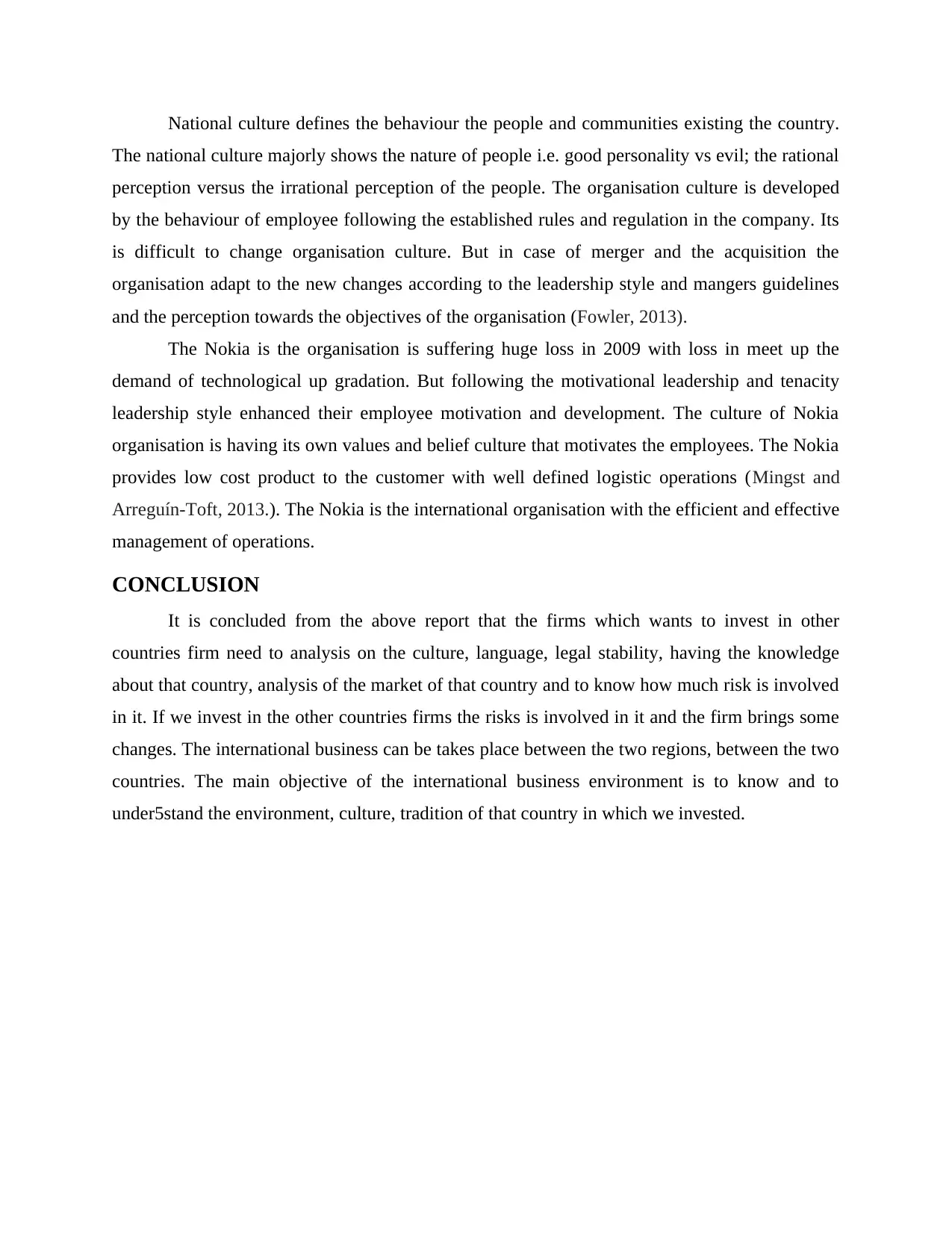
National culture defines the behaviour the people and communities existing the country.
The national culture majorly shows the nature of people i.e. good personality vs evil; the rational
perception versus the irrational perception of the people. The organisation culture is developed
by the behaviour of employee following the established rules and regulation in the company. Its
is difficult to change organisation culture. But in case of merger and the acquisition the
organisation adapt to the new changes according to the leadership style and mangers guidelines
and the perception towards the objectives of the organisation (Fowler, 2013).
The Nokia is the organisation is suffering huge loss in 2009 with loss in meet up the
demand of technological up gradation. But following the motivational leadership and tenacity
leadership style enhanced their employee motivation and development. The culture of Nokia
organisation is having its own values and belief culture that motivates the employees. The Nokia
provides low cost product to the customer with well defined logistic operations (Mingst and
Arreguín-Toft, 2013.). The Nokia is the international organisation with the efficient and effective
management of operations.
CONCLUSION
It is concluded from the above report that the firms which wants to invest in other
countries firm need to analysis on the culture, language, legal stability, having the knowledge
about that country, analysis of the market of that country and to know how much risk is involved
in it. If we invest in the other countries firms the risks is involved in it and the firm brings some
changes. The international business can be takes place between the two regions, between the two
countries. The main objective of the international business environment is to know and to
under5stand the environment, culture, tradition of that country in which we invested.
The national culture majorly shows the nature of people i.e. good personality vs evil; the rational
perception versus the irrational perception of the people. The organisation culture is developed
by the behaviour of employee following the established rules and regulation in the company. Its
is difficult to change organisation culture. But in case of merger and the acquisition the
organisation adapt to the new changes according to the leadership style and mangers guidelines
and the perception towards the objectives of the organisation (Fowler, 2013).
The Nokia is the organisation is suffering huge loss in 2009 with loss in meet up the
demand of technological up gradation. But following the motivational leadership and tenacity
leadership style enhanced their employee motivation and development. The culture of Nokia
organisation is having its own values and belief culture that motivates the employees. The Nokia
provides low cost product to the customer with well defined logistic operations (Mingst and
Arreguín-Toft, 2013.). The Nokia is the international organisation with the efficient and effective
management of operations.
CONCLUSION
It is concluded from the above report that the firms which wants to invest in other
countries firm need to analysis on the culture, language, legal stability, having the knowledge
about that country, analysis of the market of that country and to know how much risk is involved
in it. If we invest in the other countries firms the risks is involved in it and the firm brings some
changes. The international business can be takes place between the two regions, between the two
countries. The main objective of the international business environment is to know and to
under5stand the environment, culture, tradition of that country in which we invested.
Paraphrase This Document
Need a fresh take? Get an instant paraphrase of this document with our AI Paraphraser

REFRENCES
Books and Journal
Beaglehole et. al., 2011. Priority actions for the non-communicable disease crisis. The Lancet.
377(9775). pp.1438-1447.Stark, J., 2015. Product lifecycle management. In Product
Lifecycle Management (pp. 1-29). Springer International Publishing.
Bryson, J.M., 2011. Strategic planning for public and nonprofit organizations: A guide to
strengthening and sustaining organizational achievement (Vol. 1). John Wiley & Sons.
Cantwell, J., Dunning, J.H. and Lundan, S.M., 2010. An evolutionary approach to understanding
international business activity: The co-evolution of MNEs and the institutional
environment. Journal of International Business Studies. 41(4). pp.567-586.
Cavusgil. et. al., 2014. International business. Pearson Australia.
Chabbott, C., 2013. Constructing education for development: International organizations and
education for all. Routledge.
Fowler, A., 2013. Striking a balance: A guide to enhancing the effectiveness of non-
governmental organisations in international development. Routledge.
Gupta, J., Termeer, C., Klostermann, J., Meijerink, S., van den Brink, M., Jong, P., Nooteboom,
S. and Bergsma, E., 2010. The adaptive capacity wheel: a method to assess the inherent
characteristics of institutions to enable the adaptive capacity of society. Environmental
Science & Policy. 13(6). pp.459-471.
Hall, C.M. and Page, S.J., 2014. The geography of tourism and recreation: Environment, place
and space. Routledge.
Keohane, R., 2011. Neoliberal Institutionalism. Security Studies: A Reader.
Mingst, K.A. and Arreguín-Toft, I.M., 2013. Essentials of International Relations: Sixth
International Student Edition. WW Norton & Company.
Rice, A.L., 2013. The enterprise and its environment: A system theory of management
organization (Vol. 10). Routledge.
Rittberger, V., Zangl, B. and Kruck, A., 2012. International organization. Palgrave Macmillan.
Books and Journal
Beaglehole et. al., 2011. Priority actions for the non-communicable disease crisis. The Lancet.
377(9775). pp.1438-1447.Stark, J., 2015. Product lifecycle management. In Product
Lifecycle Management (pp. 1-29). Springer International Publishing.
Bryson, J.M., 2011. Strategic planning for public and nonprofit organizations: A guide to
strengthening and sustaining organizational achievement (Vol. 1). John Wiley & Sons.
Cantwell, J., Dunning, J.H. and Lundan, S.M., 2010. An evolutionary approach to understanding
international business activity: The co-evolution of MNEs and the institutional
environment. Journal of International Business Studies. 41(4). pp.567-586.
Cavusgil. et. al., 2014. International business. Pearson Australia.
Chabbott, C., 2013. Constructing education for development: International organizations and
education for all. Routledge.
Fowler, A., 2013. Striking a balance: A guide to enhancing the effectiveness of non-
governmental organisations in international development. Routledge.
Gupta, J., Termeer, C., Klostermann, J., Meijerink, S., van den Brink, M., Jong, P., Nooteboom,
S. and Bergsma, E., 2010. The adaptive capacity wheel: a method to assess the inherent
characteristics of institutions to enable the adaptive capacity of society. Environmental
Science & Policy. 13(6). pp.459-471.
Hall, C.M. and Page, S.J., 2014. The geography of tourism and recreation: Environment, place
and space. Routledge.
Keohane, R., 2011. Neoliberal Institutionalism. Security Studies: A Reader.
Mingst, K.A. and Arreguín-Toft, I.M., 2013. Essentials of International Relations: Sixth
International Student Edition. WW Norton & Company.
Rice, A.L., 2013. The enterprise and its environment: A system theory of management
organization (Vol. 10). Routledge.
Rittberger, V., Zangl, B. and Kruck, A., 2012. International organization. Palgrave Macmillan.
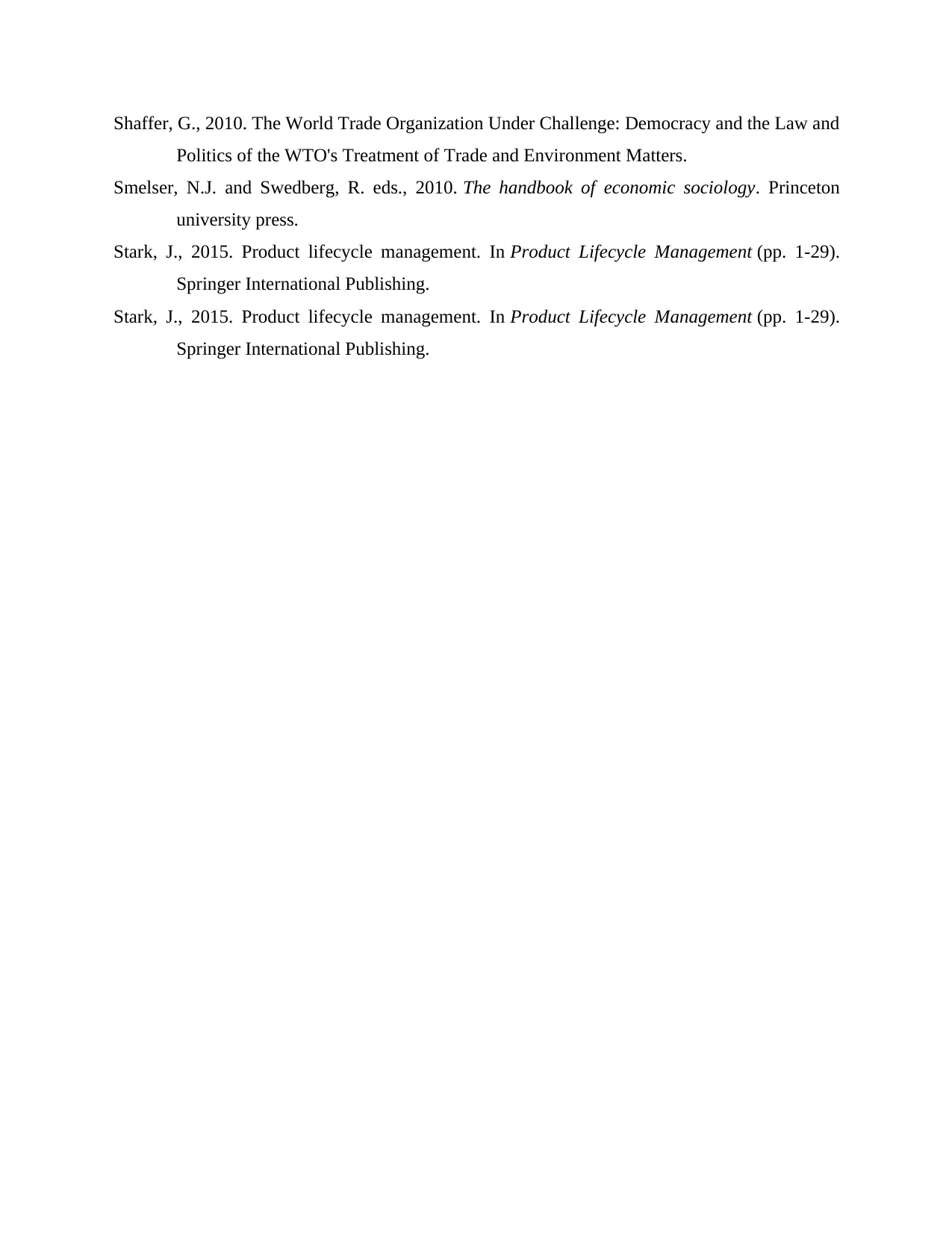
Shaffer, G., 2010. The World Trade Organization Under Challenge: Democracy and the Law and
Politics of the WTO's Treatment of Trade and Environment Matters.
Smelser, N.J. and Swedberg, R. eds., 2010. The handbook of economic sociology. Princeton
university press.
Stark, J., 2015. Product lifecycle management. In Product Lifecycle Management (pp. 1-29).
Springer International Publishing.
Stark, J., 2015. Product lifecycle management. In Product Lifecycle Management (pp. 1-29).
Springer International Publishing.
Politics of the WTO's Treatment of Trade and Environment Matters.
Smelser, N.J. and Swedberg, R. eds., 2010. The handbook of economic sociology. Princeton
university press.
Stark, J., 2015. Product lifecycle management. In Product Lifecycle Management (pp. 1-29).
Springer International Publishing.
Stark, J., 2015. Product lifecycle management. In Product Lifecycle Management (pp. 1-29).
Springer International Publishing.
⊘ This is a preview!⊘
Do you want full access?
Subscribe today to unlock all pages.

Trusted by 1+ million students worldwide
1 out of 12
Related Documents
Your All-in-One AI-Powered Toolkit for Academic Success.
+13062052269
info@desklib.com
Available 24*7 on WhatsApp / Email
![[object Object]](/_next/static/media/star-bottom.7253800d.svg)
Unlock your academic potential
Copyright © 2020–2025 A2Z Services. All Rights Reserved. Developed and managed by ZUCOL.




